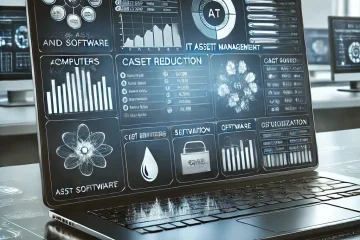Introduction
In today’s digital landscape, managing IT assets efficiently has become essential for businesses of all sizes. Whether you’re running a small business or managing a large enterprise, keeping track of IT resources such as hardware, software, and licenses is critical to operational success. That’s where IT asset management software comes in. This powerful tool not only helps businesses track and manage their IT assets but also improves overall efficiency, reduces costs, and ensures compliance. For IT companies in Delhi, partnering with a trusted software company in Delhi that specializes in asset management solutions can provide a competitive edge.
In this blog, we’ll dive deep into how IT asset management software benefits businesses and explore the key features that make it indispensable for modern IT operations.
1. Improved Asset Tracking and Visibility
One of the primary benefits of IT asset management software is its ability to provide real-time visibility into your organization’s assets. Many companies struggle with tracking IT resources, especially as they grow and expand. With multiple locations, remote employees, and a wide range of devices in use, manually tracking assets becomes impractical and prone to errors.
IT asset management software automates this process, offering a centralized dashboard that provides a comprehensive view of all your assets. This includes hardware such as computers, servers, and mobile devices, as well as software licenses and subscriptions. By knowing the location, status, and lifecycle of each asset, businesses can make more informed decisions about when to repair, replace, or upgrade equipment.
For IT companies in Delhi, where efficient use of resources is key to staying competitive, this improved visibility helps optimize asset utilization and prevents unnecessary expenditures.
2. Cost Savings through Automation
Another significant advantage of using IT asset management software is the cost savings it offers. Businesses often overspend on IT assets due to poor tracking and mismanagement. For example, without a clear understanding of which software licenses are being used, companies may end up purchasing additional licenses unnecessarily.
With IT asset management software, businesses can automate the tracking of software usage, ensuring that only the necessary licenses are purchased and maintained. Similarly, the system tracks hardware warranties and maintenance schedules, helping businesses avoid costly repairs or replacements by ensuring that equipment is serviced on time.
Additionally, automating asset tracking reduces the need for manual data entry, which not only saves time but also minimizes errors that can lead to financial losses. For businesses in Delhi, where controlling operational costs is vital for profitability, the automation offered by IT asset management software can lead to significant savings.
3. Enhanced Compliance and Security
In today’s regulatory environment, businesses must comply with various laws and standards related to IT assets. This includes software licensing agreements, data privacy regulations, and security protocols. Failing to comply with these regulations can result in hefty fines and reputational damage.
IT asset management software helps businesses ensure compliance by keeping track of all software licenses and their expiration dates. It also monitors whether the company is using the correct number of licenses according to the terms of the agreement. This prevents businesses from accidentally using unlicensed software, which can lead to legal penalties.
Additionally, the software tracks the security status of each asset, ensuring that devices are equipped with the latest security patches and updates. This helps protect the company’s IT infrastructure from cyberattacks, data breaches, and other security threats. For IT companies in Delhi, maintaining compliance and security is not just about avoiding penalties—it’s about safeguarding sensitive data and preserving client trust.
4. Optimized Asset Lifecycles
Every IT asset, whether it’s a server or a piece of software, has a lifecycle that includes procurement, usage, maintenance, and disposal. Managing these lifecycles efficiently is critical to maximizing the value of your IT investments. IT asset management software provides tools to track each stage of the asset lifecycle, from acquisition to retirement.
For instance, the software can monitor when a server is due for maintenance or when a software license is about to expire. This allows businesses to plan ahead and budget for replacements or renewals before issues arise. By managing assets proactively rather than reactively, companies can avoid unexpected downtime and ensure that their IT infrastructure is always running smoothly.
For IT companies in Delhi, where downtime can lead to lost revenue and dissatisfied clients, optimizing asset lifecycles through proactive management is essential for maintaining operational efficiency.
5. Integration with Other Business Systems
IT asset management software can integrate with other business systems such as enterprise resource planning (ERP), customer relationship management (CRM), and financial management platforms. This integration ensures that data flows seamlessly between departments, enabling more accurate reporting and analysis.
For example, integrating IT asset management software with an ERP system allows businesses to track the financial impact of their IT assets more effectively. They can monitor the depreciation of hardware, the total cost of ownership for each asset, and the return on investment (ROI) for IT purchases. Similarly, integrating with a CRM system helps track how IT assets are being used to support customer interactions and sales activities.
By integrating IT asset management software with other business systems, companies can gain a holistic view of their operations, leading to better decision-making and more efficient resource allocation.
6. Scalability for Growing Businesses
As businesses grow, so do their IT needs. Managing a few assets manually might be feasible for a small business, but as the company expands, this approach becomes unsustainable. IT asset management software is designed to scale with your business, ensuring that you can manage a growing number of assets without losing control.
Whether you’re adding new office locations, onboarding remote employees, or adopting new technologies, IT asset management software provides the tools needed to track and manage assets across multiple locations and departments. This scalability is particularly important for IT companies in Delhi that are experiencing rapid growth and need to manage increasing amounts of hardware and software effectively.
7. Better Decision-Making with Data Analytics
IT asset management software offers powerful data analytics tools that provide insights into asset performance, usage trends, and total costs. By analyzing this data, businesses can make more informed decisions about when to invest in new technology, how to optimize their IT infrastructure, and where to cut costs.
For example, the software can identify which assets are underperforming or being underutilized, allowing businesses to reallocate resources or invest in more efficient equipment. It can also help companies predict future IT needs based on current usage patterns, enabling better planning and budgeting.
For IT companies in Delhi, having access to this level of insight is invaluable for staying competitive in a fast-paced market. Data-driven decision-making ensures that businesses can optimize their IT assets and achieve long-term success.
Conclusion
Investing in IT asset management software is no longer a luxury for businesses—it’s a necessity. By automating asset tracking, improving compliance, reducing costs, and providing valuable insights, IT asset management software enables businesses to optimize their IT infrastructure and stay competitive in today’s digital world. For IT companies in Delhi, partnering with a trusted software company in Delhi to implement and manage IT asset management solutions can lead to greater operational efficiency, improved security, and long-term business success.



0 Comments